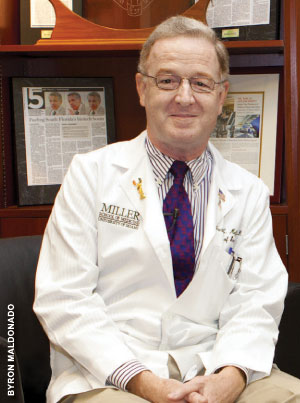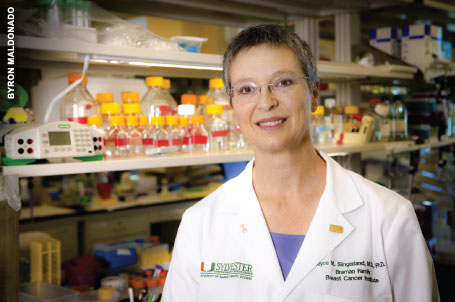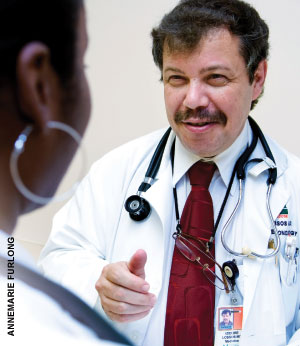His grandfather sure knew how to deliver a surgeon: All four of his sons became surgeons. So when the family patriarch delivered his second son’s first-born, in Port Colborne, Ontario, there was no doubt baby Fred Moffat would become a surgeon—an oncology surgeon, as it turned out—and a darn good one. Not only was the early technical wizard the chief resident in the busiest hospital in Toronto; he learned from the best, Drs. Rudy Falk and Alfred Ketcham, that patients with cancer should never have to face their disease without hope.
With wife Jenny (Simpson, M.D., internal medicine) and two sons, the Moffats left Canada permanently for subtropical Miami in 1988. They first came for two years of fellowship training in 1984, initially renting an unairconditioned house on Lisbon Street where, as the neighborhood’s only Anglos, they discovered Cuban-American hospitality, key to their integration.
Among Fred’s patients are women with newly discovered breast lesions, their lives in limbo. But enter Dr. Moffat with his uncanny ability to strike the perfect interpersonal tone. Honestly realistic but with hopeful optimism, he summons their personal fortitude and emotional stamina. Before you know it, his patients are looking the disease squarely in the eye, determined to endure and outlast treatment. Fred Moffat knows too well the limits, but always makes sure his patients remain engaged, refusing to surrender hope. Even if the cancer ultimately claims them, Fred never lets cancer get the best of them.
He and a few of his peers led the revolution of medical oncologists who attack the disease with chemo, hormonal, and radiation therapy before surgery, enabling them to measure the response and reduce the scope of resection. He also learned how capricious cancer can be. One older patient with metastatic melanoma gave up, and headed to a dock in the Keys with a six-pack of beer. When the patient returned disease-free, Fred had two questions: “Where the heck is that dock, and what kind of beer were you drinking?”
 |
| Fred Moffat, M.D., an oncology surgeon at Sylvester and professor of surgery at the Miller School, combines outstanding technical expertise in a variety of malignancies with innovative therapies and an engaging bedside manner that encourages patients to keep hope alive. |
One day, Fred knows a new solution will hold cancer’s mortality and morbidity at bay. For now, he’ll continue stacking the deck as far in favor of patients as he can, helping them realize,
“I can get through this.’’
Elsewhere in Canada, Quebec City to be specific, an extraordinary thought leader and advocate for breast cancer patients was born to a family of girls. With three sisters, young Joyce Slingerland learned early how to bond with women, but it was Ross Varley, a carrot-haired high school teacher, who nurtured her interest in biological wonders. The chloroplast, photosynthesis, the cell membrane, cytoskeleton, nucleus, DNA, RNA, protein production—she was fascinated by it all, particularly the decision of cells to divide. With her dad, she watched amoebas collected from the snow swim under the microscope and, from time to time, split in half.
She was mesmerized by how, for example, lung tissue starts with the trachea, then divides into bronchial hollow tubes, then smaller bronchioles, then the alveoli, where trade occurs between oxygen and carbon dioxide within a strange but highly organized universe of lipid particles, red cells, air, and water. These hollow tubes are the marketplace where business is transacted, with wears and tears that sometimes leave a scar that can lead to cancer.
How does one maintain sanity when part of everyday life is spent with patients whose vicious cancers are stealing theirs? Joyce learned some soul-saving tricks, such as a drop of perfume on her wrist to remind her of the beauty of life. Now she is restored by her husband Richard Tiberius’s nature paintings, her own music, and the redemptive beauty of her relationships with her patients—bonds that allow her to understand what it means when they say, “I am not done with life yet; it is not my time.”
Then she can come back with a vengeance to find the biological Achilles’ heel, the tumor suppressors, the inhibitors of oncogenes. Her goal: to destroy cancer cells, to bring into check the unique propensity of cancer cells, which show such little regard for the beauty of life, to divide.
 |
| Joyce Slingerland, M.D., Ph.D., director of the Braman Family Breast Cancer Institute at Sylvester and professor of medicine and director of translational research at the Miller School, leads collaborative efforts to discover effective new ways to inhibit the proliferation of cancer cells. |
Joyce and Richard have a daughter, Kiry, a vocal performer who wants to sing opera. Kiry uses the hollow respiratory system that so fascinated her mother to move air through the cords of her human instrument and, like her mother, finds redemption in the beauty of music. She and her mom are close, and Joyce rejoices in their relationship. For a woman who has done so much for her sisters, for her patients, and for all the patients she will never meet, that is no surprise. Neither will it be when Joyce and the team of exceptional doctors and scientists she has built at the Braman Family Breast Cancer Institute help eradicate the ugly face of breast cancer.
Izidore Lossos was born in the Gulag, in cold-ridden Siberia, the son of survivors of the Stalin regime. Originally from Lithuania, his parents endured the Russian labor camps, where freedom of speech did not exist and modern health care did not reach. Izidore found liberty in the knowledge of multiple languages, learning Russian, Lithuanian, Yiddish, Hebrew, and English. He always made the best of the cards he was dealt, enjoyed skiing and hockey as a boy, never quenching his thirst for knowledge. Eventually, his family was able to return to Lithuania and emigrate to Israel, where his father died of cardiovascular complications. There were no antibiotics in Siberia to prevent the rheumatic fever that destroyed the valves of his heart.
Izidore was a fast learner, skipping grades. He went to medical school, and served in the Israeli army, where he learned to make sound clinical decisions under fire. On his one free weekend a month, he’d spend one day in the hospital to keep up his skills, and the other with wife Elena, a violinist, and their son and daughter.
In his fourth year of medical school, he diagnosed his first case of lymphoma—in his own mother. Unbeknown to her doctors, she had developed chronic lymphocytic leukemia, which took a severe and fatal turn called Richter’s Transformation.
 |
| Izidore Lossos, M.D., a hematologist-oncologist, associate professor of medicine at the Miller School, and head of the Lymphoma Program, overcame personal challenges to become
one of the world’s leading experts in lymphoma and has led groundbreaking studies that have greatly enhanced understanding of the disease. |
Today Dr. Lossos is one of the world’s experts in lymphoma—the expert you want at your side when you face such a diagnosis. Lymphomas represent an esoteric grouping of cancers best managed by those who understand the biological pathways involved in their formation. From molecular mutation of DNA hot spots to epigenetic alteration of the chromatin, lymphoma can destroy organs like the liver in just a couple of weeks.
Dr. Lossos left Israel for Stanford in Palo Alto, where, working with the best team, he learned the subtleties of the molecular accidents that form lymphomas. He learned how common viruses like Epstein-Barr can trick immune cells and their stem progenitors to transform into cancerous cells. He learned how the apoptosis (programmed cell death) suppressive gene can make cells that don’t divide rapidly survive indefinitely and defy the normal turnover of non-cancerous cells.
He could have stayed at Stanford, but when visiting Miami, he realized he would never find such unique patients. They came from everywhere in Latin America and the Caribbean with undiagnosed lymphoma and diseases affected by a variety of cultures, environments, and genetic modifications. In the rich mind of Izidore Lossos, crossing the bridge from Siberia, to Israel, to California, to Miami was easy. An immense scientific and medical frontier lay before him, and he has done beautifully, opening the medical and scientific space of lymphoma. Even with all the progress made, Izidore might not have been able to save his mother today, but he is saving so many other patients.
These are just three of our champions at Sylvester Comprehensive Cancer Center; each represents the expertise, drive, and courage of our team of doctors, nurses, and staff. Thirty years ago, Harcourt Sylvester made a gift to UM that would change its course. “Throw a stone and watch the ripples flow...” Every day more lives are saved, more discoveries are made, and cures for many cancers draw closer. We are all touched by and at risk for cancer ailments, but it is so reassuring to be next to such an extraordinary team of cancer fighters who are bringing new hope every day.
To watch the interviews and read the full transcripts, go to http://med.miami.edu/deansoffice/deans-perspective/2011-spring. |
 |
 |


